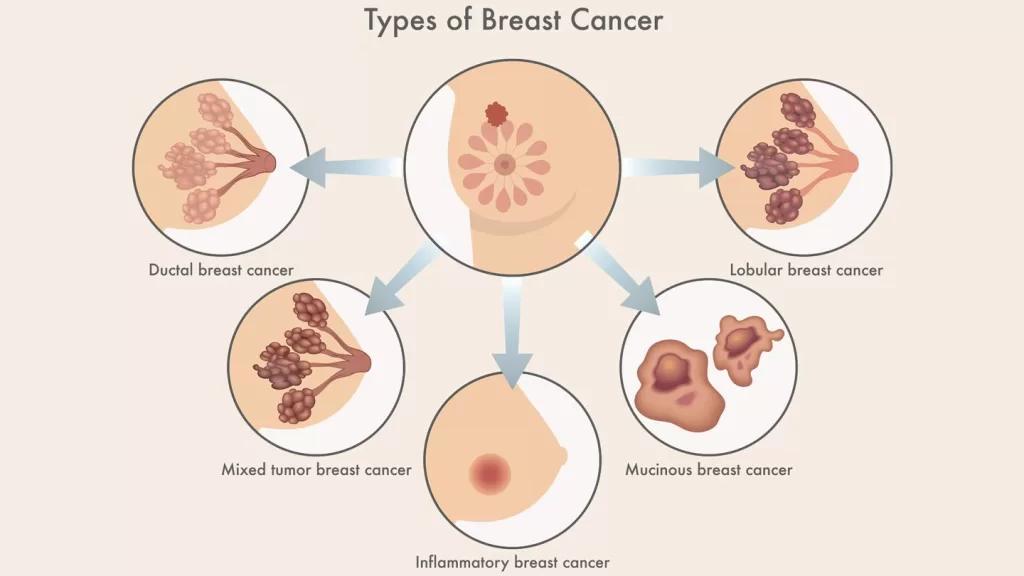Breast cancer is an abnormal growth of cells in the breast. These abnormal cells divide more rapidly and accumulate in an area to form a mass. However, the cells can spread to other areas of the breast or to other parts of the body.
Types of Breast Cancer.
- Inflammatory.
- Paget’s disease of the breast.
- Ductal carcinoma in situ.
- Also, invasive lobular carcinoma.
- Triple-negative.
- Lobular carcinoma in situ.
- Infiltrating ductal carcinoma.
Symptoms.
- Change in the size and appearance of the breast.
- Also, feeling like one has a lump/mass in the breast.
- Scaling, and peeling off the breast skin or the area around the areola.
- Redness of skin over the breast.
Risk factors of breast cancer.
- Age – So, people past menopause are at a high risk of developing breast cancer than those in their reproductive age.
- Gender- women have more breast cancer cases than men.
- Breast cancer personal history.
- Family history.
- Radiation exposure.
- Obesity.
- Having undergone postmenopausal hormone therapy.
- Also, late childbirth.
- Women who don’t have children have a high risk.
- Early adolescence stage.
- Alcohol consumption.
Prevention.
- Breast screening such as mammograms and clinical breast examinations.
- Maintain a normal healthy weight by eating healthy to avoid being obese.
- Limit the use of postmenopausal hormone therapy.
- Regular exercising to prevent unhealthy weight gain.
- Control alcohol consumption.
- The self-breast examination helps one become more familiar with their breast thus making it easy to note any abnormal changes.
Diagnosis.
- Breast exams are where the doctor asses for lumps in the breast, and lymph nodes in the armpits.
- Breast ultrasound.
- Mammogram – this is an x-ray of the breast.
- Breast biopsy where a small tissue of the suspected area is removed and examined.
- Magnetic resonance imaging of the breast shows the interior appearance of the breast.

Treatment.
The method of treatment for breast cancer depends on :
- Type of breast cancer.
- Stage.
- Size of the breast lump.
- Sensitivity of the cancer cells to hormones.
- Radiation therapy- high energy beams are used to kill the cancer cells.
- Use of target drug therapy –
- Chemotherapy- drugs are used to kill the cancer cells. It is sometimes done after a surgical removal of the breast when the doctor thinks there is a chance of the cancer returning.
- Hormone therapy – This is used to treat breast cancers that are sensitive to hormones where they can either be blocked from attaching to the cancer cells or stop the body from producing estrogen.
- Immunotherapy- one’s body’s immune system fights the cancer cells.
- Palliative care – due to pain from the cancer symptoms it’s good to ensure the clients are comfortable by giving both physical and emotional support.
- Surgery- is of many types. They include:
- Mastectomy – this is the surgical removal of the entire breast.
- Lumpectomy- the lump plus a small healthy tissue of the breast is removed. Done on small tumors.
- Contralateral prophylactic mastectomy where both breasts are removed completely even if only one breast is the one that has cancer. Done when the risk of cancer is high due to genetics of family history.
- Sentinel node biopsy to determine if the cancer has spread to the lymph nodes.
- Axillary lymph node dissection is done when cancer has spread to the lymph nodes.
- Mount Kenya University history, fees, courses
- List of best private primary schools in Kirinyaga County.
- Bay head elementary school history, enrolment, programs offered.
- Kenya Institute of special education, courses.
- A list of special secondary schools, and contacts.
- List of Best private secondary schools in Nairobi County.
- Best Public High Schools in Kiambu County.